Coordinated Control of Single-Phase End-Users for Phase Load Balancing in Active Electric Distribution Networks
Abstract
:1. Introduction
1.1. Related Literature
1.2. Our Contributions
- Implementing a procedure to real-time work for the simultaneous query of three different databases (Topology Database, SMS Database, and End-Users Database) of the DNO for uploading the necessary input data in the PLB process. This procedure allows fast data processing.
- Proposing an original PLB algorithm applied for other possible PLB cases encountered in the AEDNs: consumer-level (C-PLB), prosumer-level (P-PLB), or hybrid-level (H-PLB) for all 1-P end-users (prosumers and consumers), running regardless of the status of the SSDs (available or unavailable) and the participation degree of the end-users (depending on the absorbed/injected current, equal or different to 0, and the 1-P end-user being considered in the PLB process).
- Conducting a complex study where all possible PLB cases represented by C-PLB, P-PLB, and H-PLB to confirm the accuracy of the proposed methodology, regardless of the structure and participation degree of the end-users.
1.3. Paper Organization
2. Methodology
2.1. Database Management
2.1.1. Topology Database
2.1.2. SMS and End-Users Database
- Supply Point is associated with each EDS through the identification number of the data concentrator having as principal function to collect the data read from the smart meters installed at the end-users allocated to the EDS. This point represents the link with the electric distribution network operated at the medium voltage by the DNO.
- EDS record allows the decision maker to locate the EDS in the network based on its name. Additionally, the information offers the opportunity to identify extremely fast the supplied HV/MV electric substation.
- Sampling Step has a significant influence on data processing. The sampling step of the load curve can be programmable between 5 and 60 min (the normative values being 5, 15, 30, and 60 min). The data sampling of the smart meters installed by the DNOs to the end-users is 60 min in most cases.
- Hour contains the information corresponding to the time with individual hour, minute, and second components (hh:mm:ss) of the recording the value of the load (current or power).
- The next columns record the loads (current or power) transmitted by each smart meter recognized through an identification number in the database (for example, 1009142000000391).
2.2. The PLB Mathematical Model
3. Case Study
4. Conclusions
Supplementary Materials
Author Contributions
Funding
Institutional Review Board Statement
Informed Consent Statement
Conflicts of Interest
References
- Baker, P. Challenges Facing Distribution System Operators in a Decarbonised Power System. Regulatory Assistance Project. 2020. Available online: https://www.raponline.org/wp-content/uploads/2020/05/rap-baker-dso-challenges-june-2020-final.pdf (accessed on 7 September 2021).
- Liu, J.; Gao, H.; Ma, Z.; Li, Y. Review and prospect of active distribution system planning. J. Mod. Power Syst. Clean Energy 2015, 3, 457–467. [Google Scholar] [CrossRef] [Green Version]
- European Commission. Clean Energy for All Europeans Package. Available online: https://ec.europa.eu/energy/topics/energy-strategy/clean-energy-all-europeans_en (accessed on 18 November 2020).
- Internal Energy Agency. Digitalization & Energy. October 2017. Available online: https://iea.blob.core.windows.net/assets/b1e6600c-4e40-4d9c-809d-1d1724c763d5/DigitalizationandEnergy3.pdf (accessed on 7 September 2021).
- Li, R.; Wang, W.; Chen, Z.; Jiang, J.; Zhang, W. A Review of Optimal Planning Active Distribution System: Models, Methods, and Future Researches. Energies 2017, 10, 1715. [Google Scholar] [CrossRef] [Green Version]
- Mishra, D.K.; Ghadi, M.J.; Azizivahed, A.; Li, L.; Zhang, J. A review on resilience studies in active distribution systems. Renew. Sustain. Energy Rev. 2021, 135, 110201. [Google Scholar] [CrossRef]
- Beharrysingh, S. Phase Unbalance on Low-Voltage Electricity Networks and Its Mitigation Using Static Balancers. Ph.D. Thesis, Loughborough University, Loughborough, UK, 2014. Available online: https://dspace.lboro.ac.uk/dspace-jspui/handle/2134/16252 (accessed on 7 September 2021).
- Toader, C.; Porumb, R.; Bulac, C.; Tristiu, I. A perspective on current unbalance in low voltage distribution networks. In Proceedings of the 2015 9th International Symposium on Advanced Topics in Electrical Engineering (ATEE), Bucharest, Romania, 7–9 May 2015; pp. 741–746. [Google Scholar]
- Ojo, A.; Awodele, K.; Sebitosi, A. Load Compensation in a Three-Phase Four Wire Distribution System Considering Unbalance, Neutral Current Elimination and Power Factor Improvement. In Proceedings of the 2019 Southern African Universities Power Engineering Conference/Robotics and Mechatronics/Pattern Recognition Association of South Africa (SAUPEC/RobMech/PRASA), Bloemfontein, South Africa, 28–30 January 2019; pp. 389–394. [Google Scholar]
- Qudah, M.; Abu Elhaija, W.; Widyan, M. Performance analysis of different series compensation schemes of SMIB power system incorporating PV generator. Int. Trans. Electr. Energy Syst. 2021, 31, e12699. [Google Scholar] [CrossRef]
- Gebru, Y.; Bitew, D.; Aberie, H.; Gizaw, K. Performance enhancement of radial distribution system using simultaneous network reconfiguration and switched capacitor bank placement. Cogent Eng. 2021, 8, 1897929. [Google Scholar] [CrossRef]
- Vai, V.; Suk, S.; Lorm, R.; Chhlonh, C.; Eng, S.; Bun, L. Optimal Reconfiguration in Distribution Systems with Distributed Generations Based on Modified Sequential Switch Opening and Exchange. Appl. Sci. 2021, 11, 2146. [Google Scholar] [CrossRef]
- Shahnia, F.; Wolfs, P.; Ghosh, A. Voltage Unbalance Reduction in Low Voltage Feeders by Dynamic Switching of Residential Customers Among Three Phases. IEEE Trans. Smart Grid 2014, 5, 1318–1327. [Google Scholar] [CrossRef] [Green Version]
- Bao, G.; Ke, S. Load Transfer Device for Solving a Three-Phase Unbalance Problem Under a Low-Voltage Distribution Network. Energies 2019, 12, 2842. [Google Scholar] [CrossRef] [Green Version]
- Grigoraș, G.; Neagu, B.-C.; Gavrilaș, M.; Triștiu, I.; Bulac, C. Optimal Phase Load Balancing in Low Voltage Distribution Networks Using a Smart Meter Data-Based Algorithm. Mathematics 2020, 8, 549. [Google Scholar] [CrossRef] [Green Version]
- Liu, B.; Meng, K.; Dong, Z.Y.; Wong, P.K.C.; Li, X. Load Balancing in Low-Voltage Distribution Network via Phase Reconfiguration: An Efficient Sensitivity-Based Approach. IEEE Trans. Power Deliv. 2021, 36, 2174–2185. [Google Scholar] [CrossRef]
- Haq, S.U.; Arif, B.; Khan, A.; Ahmed, J. Automatic three phase load balancing system by using fast switching relay in three phase distribution system. In Proceedings of the 2018 1st International Conference on Power, Energy and Smart Grid (ICPESG), Mirpur Azad Kashmir, Pakistan, 9–10 April 2018; pp. 1–6. [Google Scholar]
- Homaee, O.; Najafi, A.; Dehghanian, M.; Attar, M.; Falaghi, H. A practical approach for distribution network load balancing by optimal re-phasing of single phase customers using discrete genetic algorithm. Int. Trans. Electr. Energy Syst. 2019, 29, e2834. [Google Scholar] [CrossRef]
- Grigoraș, G.; Neagu, B.-C.; Scarlatache, F.; Noroc, L.; Chelaru, E. Bi-Level Phase Load Balancing Methodology with Clustering-Based Consumers’ Selection Criterion for Switching Device Placement in Low Voltage Distribution Networks. Mathematics 2021, 9, 542. [Google Scholar] [CrossRef]
- Sureshkumar, R.; Maithili, P. Three Phase Load Balancing And Energy Loss Reduction In Distribution Network Using Labiew. Int. J. Pure Appl. Math. 2017, 116, 181–189. [Google Scholar]
- Abril, I.P. Multi-objective optimization of the balancing of phases in primary distribution circuits. Int. J. Electr. Power Energy Syst. 2016, 82, 420–428. [Google Scholar] [CrossRef]
- Singh, D.; Misra, R.K.; Mishra, S. Distribution system feeder re-phasing considering voltage-dependency of loads. Int. J. Electr. Power Energy Syst. 2016, 76, 107–119. [Google Scholar] [CrossRef]
- Siti, W.M.; Jimoh, A.; Nicolae, D. Distribution network phase load balancing as a combinatorial optimization problem using fuzzy logic and Newton–Raphson. Electr. Power Syst. Res. 2011, 81, 1079–1087. [Google Scholar] [CrossRef]
- Pan, J.; Liu, J.; Chen, X.; Zhong, K. Three-phase unbalanced load control based on load–electricity transfer index. Energy Rep. 2021, 7, 312–318. [Google Scholar] [CrossRef]
- Caldognetto, T.; Tenti, P.; Mattavelli, P.; Buso, S.; Brandao, D. Cooperative compensation of unwanted current terms in low-voltage microgrids by distributed power-based control. In Proceedings of the 2015 IEEE 13th Brazilian Power Electronics Conference and 1st Southern Power Electronics Conference (COBEP/SPEC), Fortaleza, Brazil, 29 November–2 December 2015; pp. 1–7. [Google Scholar]
- Brandao, D.I.; Caldognetto, T.; Marafão, F.; Simoes, M.G.; Pomilio, J.A.; Tenti, P. Centralized Control of Distributed Single-Phase Inverters Arbitrarily Connected to Three-Phase Four-Wire Microgrids. IEEE Trans. Smart Grid 2017, 8, 437–446. [Google Scholar] [CrossRef] [Green Version]
- Blaud, P.C.; Haurant, P.; Claveau, F.; Lacarrière, B.; Chevrel, P.; Mouraud, A. Modelling and control of multi-energy systems through Multi-Prosumer Node and Economic Model Predictive Control. Int. J. Electr. Power Energy Syst. 2020, 118, 105778. [Google Scholar] [CrossRef]
- Mieński, R.; Urbanek, P.; Wasiak, I. Using Energy Storage Inverters of Prosumer Installations for Voltage Control in Low-Voltage Distribution Networks. Energies 2021, 14, 1121. [Google Scholar] [CrossRef]
- Soltani, S.; Rashidinejad, M.; Abdollahi, A. Dynamic phase balancing in the smart distribution networks. Int. J. Electr. Power Energy Syst. 2017, 93, 374–383. [Google Scholar] [CrossRef]
- Wang, W.; Yu, N. Phase Balancing in Power Distribution Network with Data Center. ACM Sigmetrics Perform. Eval. Rev. 2017, 45, 64–69. [Google Scholar] [CrossRef]
- Chen, C.-S.; Tsai, C.-T.; Lin, C.-H.; Hsieh, W.-L.; Ku, T.-T. Loading Balance of Distribution Feeders With Loop Power Controllers Considering Photovoltaic Generation. IEEE Trans. Power Syst. 2011, 26, 1762–1768. [Google Scholar] [CrossRef]
- Charalambous, A.; Hadjidemetriou, L.; Zacharia, L.; Bintoudi, A.D.; Tsolakis, A.C.; Tzovaras, D.; Kyriakides, E. Phase Balancing and Reactive Power Support Services for Microgrids. Appl. Sci. 2019, 9, 5067. [Google Scholar] [CrossRef] [Green Version]
- Ciontea, C.; Iov, F. A Study of Load Imbalance Influence on Power Quality Assessment for Distribution Networks. Electricity 2021, 2, 77–90. [Google Scholar] [CrossRef]
- Kwaśny, L.; Zieliński, D. Control of a Four-wire Hybrid Prosumer Converter for Balancing Utility Grids. Power Electron. Drives 2021, 6, 1–11. [Google Scholar]
- Drabek, T.; Dybowski, P. Control of prosumer voltage sources in distribution grids. In Proceedings of the 2020 12th International Conference and Exhibition on Electrical Power Quality and Utilisation (EPQU), Cracow, Poland, 14–15 September 2020; pp. 1–6. [Google Scholar]
- Volosciuc, S.D.; Dragosin, M.E. Prosumer’s impact on low voltage distribution networks. Proc. MATEC Web Conf. EDP Sci. 2019, 290, 01021. [Google Scholar] [CrossRef] [Green Version]
- Grigoras, G.; Neagu, B.-C. Smart Meter Data-Based Three-Stage Algorithm to Calculate Power and Energy Losses in Low Voltage Distribution Networks. Energies 2019, 12, 3008. [Google Scholar] [CrossRef] [Green Version]
- Munakata, T.; Barták, R. Logic programming for combinatorial problems. Artif. Intell. Rev. 2010, 33, 135–150. [Google Scholar] [CrossRef] [Green Version]
- Shan, X. (Gene); Felder, F.A.; Coit, D.W. Game-theoretic models for electric distribution resiliency/reliability from a multiple stakeholder perspective. IISE Trans. 2017, 49, 159–177. [Google Scholar] [CrossRef]
- Romanian Energy Regulatory Authority, Report on the Performance Indicators for Electric Transmission, System and Distribution Services and the Technical State of Electric Transmission and Distribution Networks in 2018, Romania. 2019. Available online: https://www.anre.ro/ro/energie-electrica/rapoarte/rapoarte-indicatori-performanta (accessed on 15 September 2021). (In Romanian).
- Baričević, T.; Skok, M.; Majstrović, G.; Perić, K.; Brajković, J. South East European Distribution System Operators Benchmarking Study. Available online: https://www.usea.org/sites/default/files/SEE%20DSO%20Benchmarking%20Study%202008%20-%202015%20-%20final.pdf (accessed on 15 September 2021).
- Ivanov, O.; Grigoras, G.; Neagu, B.C. Smart Metering based Approaches to Solve the Load Phase Balancing Problem in Low Voltage Distribution Networks. In Proceedings of the 2018 International Symposium on Fundamentals of Electrical Engineering (ISFEE), Bucharest, Romania, 1–3 November 2018; pp. 1–6. [Google Scholar] [CrossRef]
- Ivanov, O.; Neagu, B.-C.; Gavrilas, M.; Grigoras, G.; Sfintes, C.-V. Phase Load Balancing in Low Voltage Distribution Networks Using Metaheuristic Algorithms. In Proceedings of the 2019 International Conference on Electromechanical and Energy Systems (SIELMEN), Craiova, Romania, 9–11 October 2019; pp. 1–6. [Google Scholar]
- Pillay, P.; Manyage, M. Definitions of voltage unbalance. IEEE Power Eng. Rev. 2001, 21, 50–51. [Google Scholar] [CrossRef]
- Bollen, M. Definitions of voltage unbalance. IEEE Power Eng. Rev. 2002, 22, 49–50. [Google Scholar] [CrossRef]
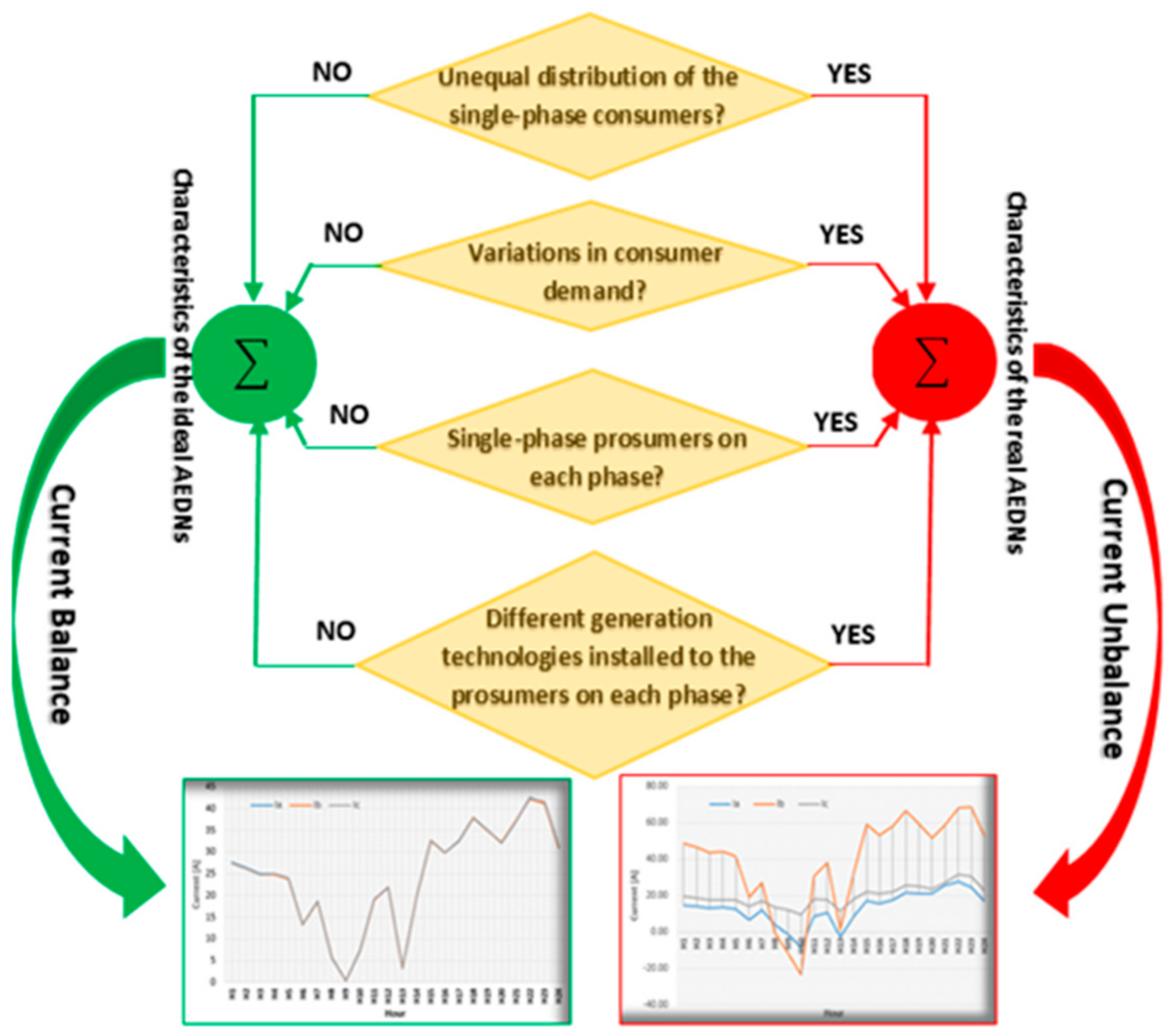
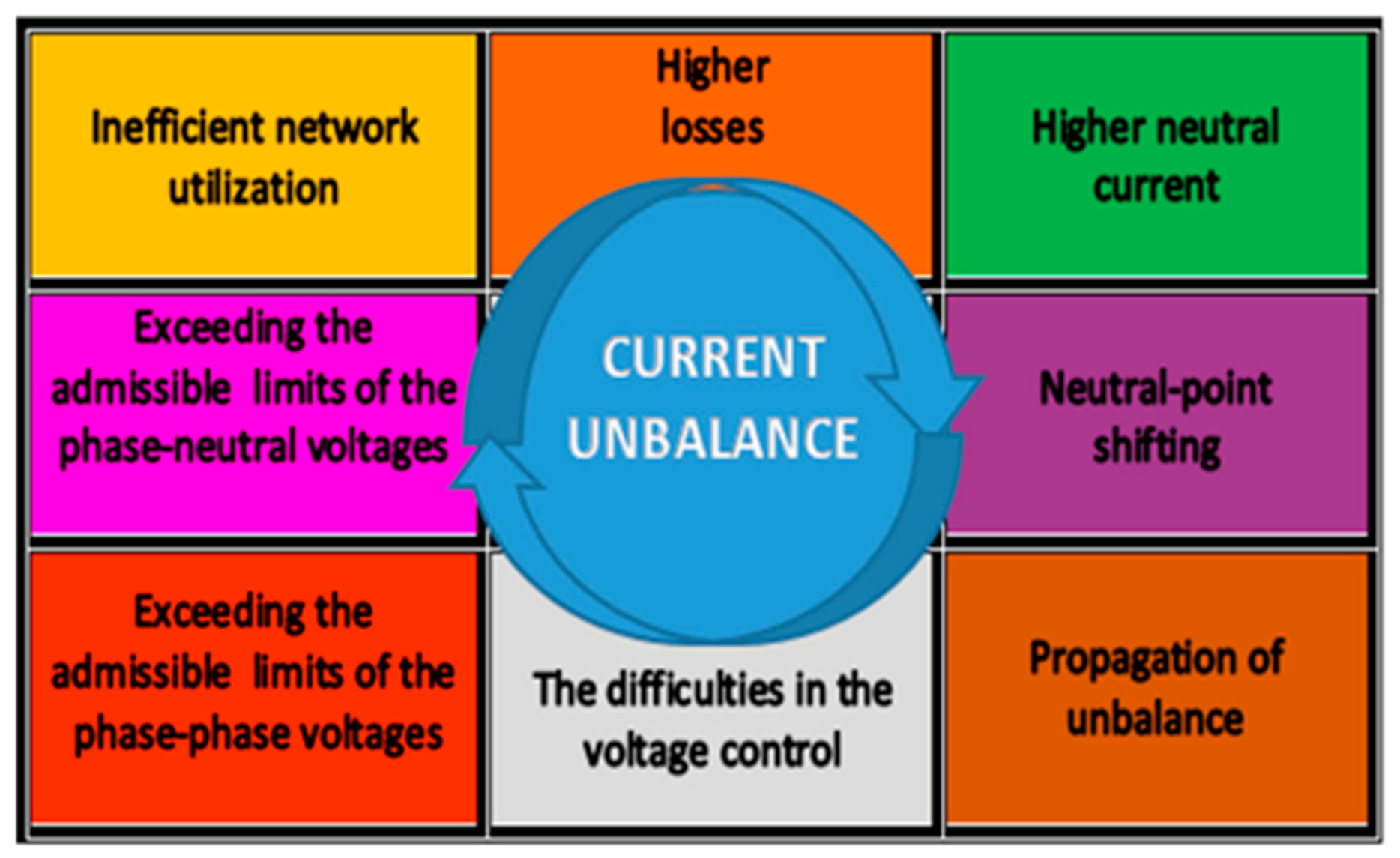
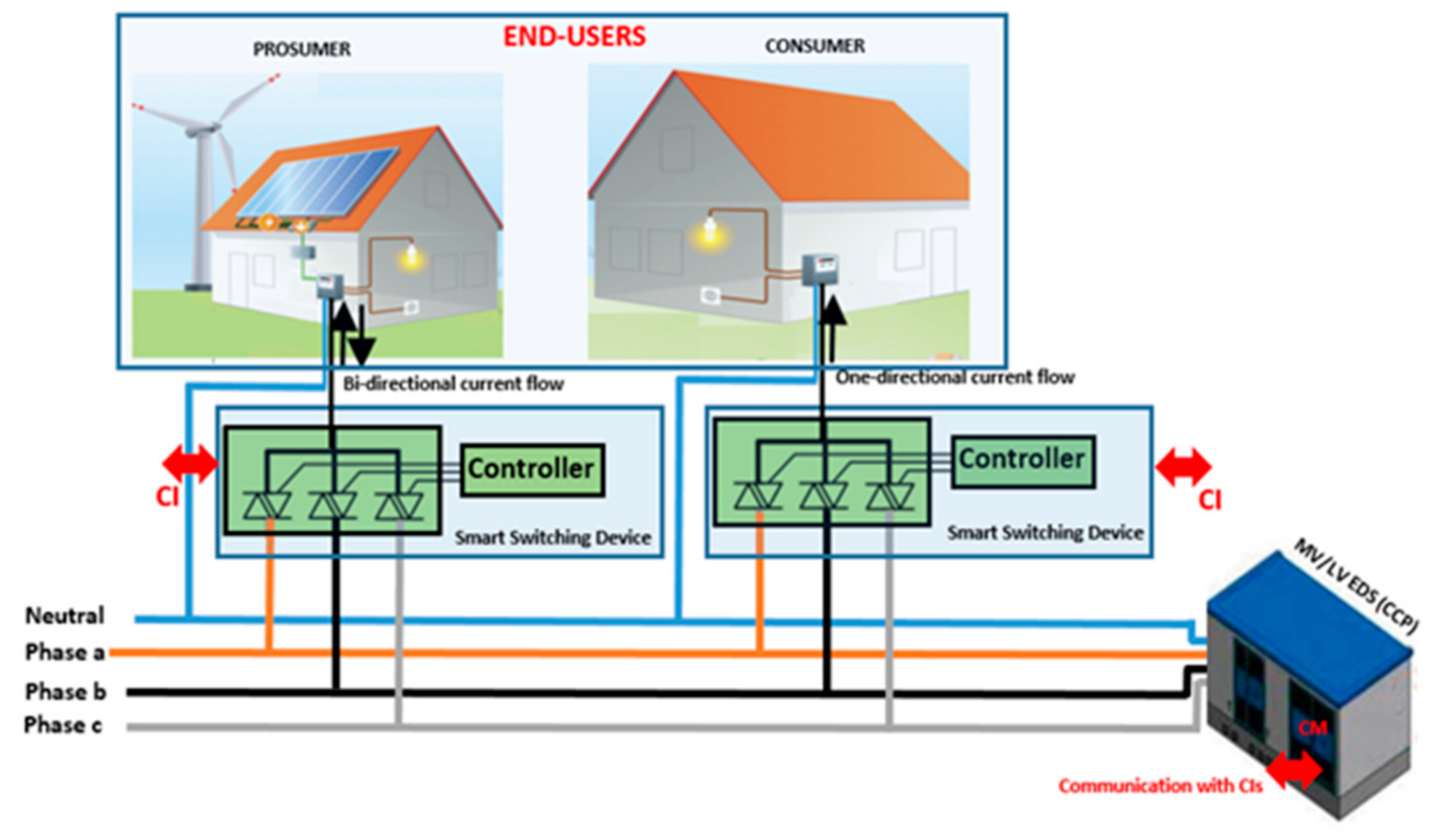

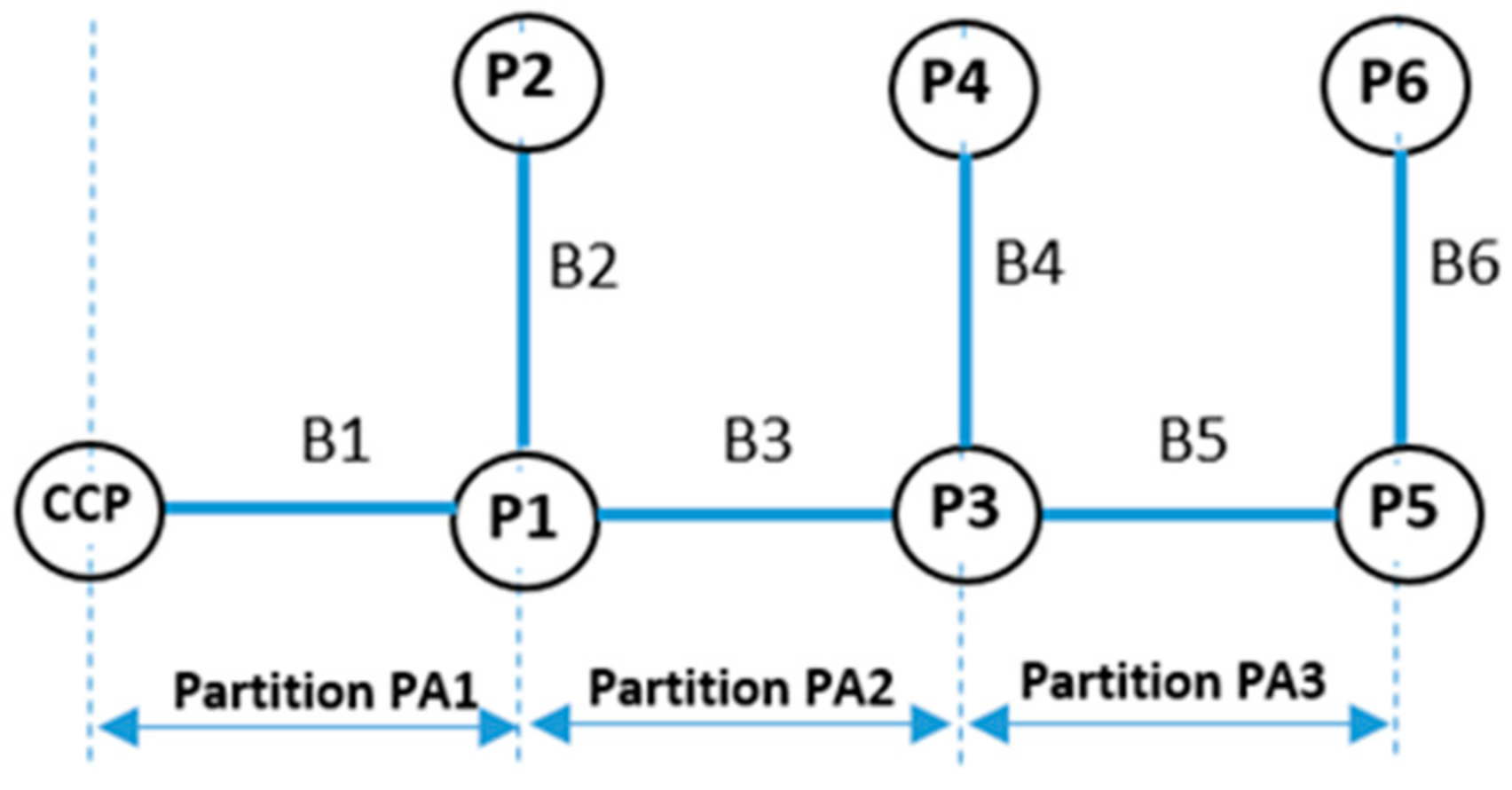
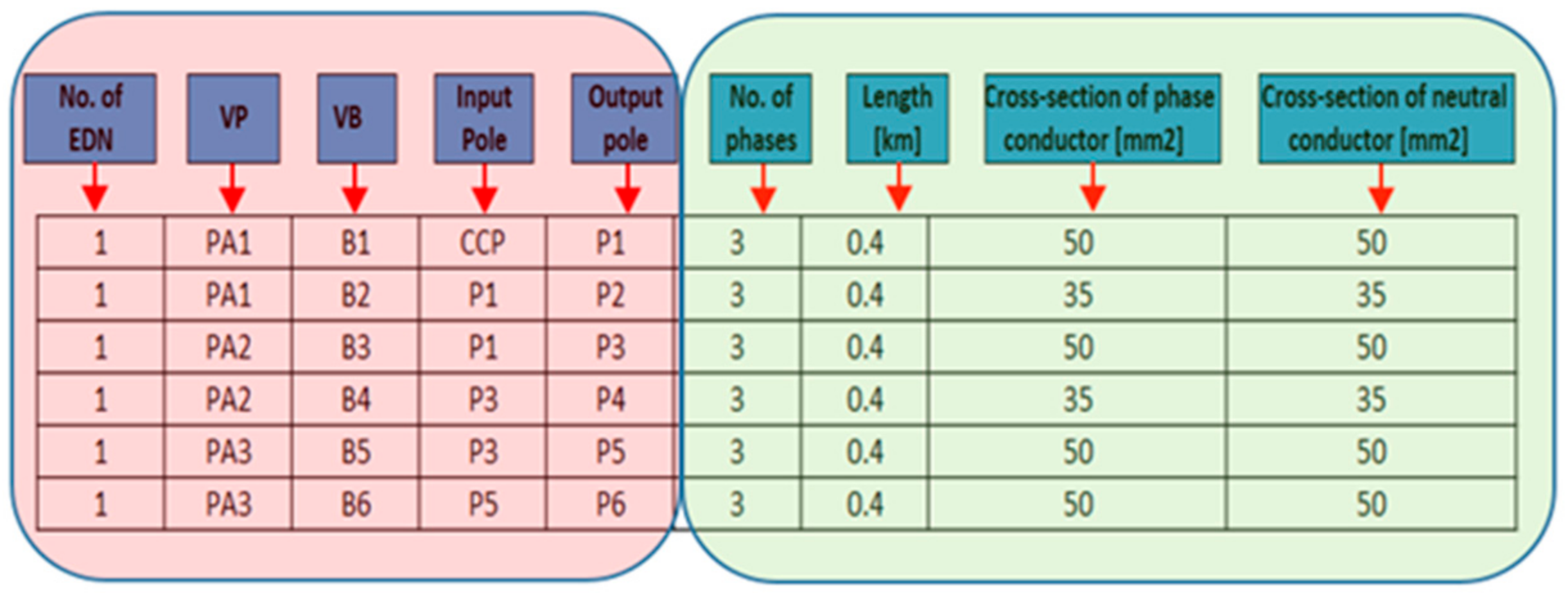
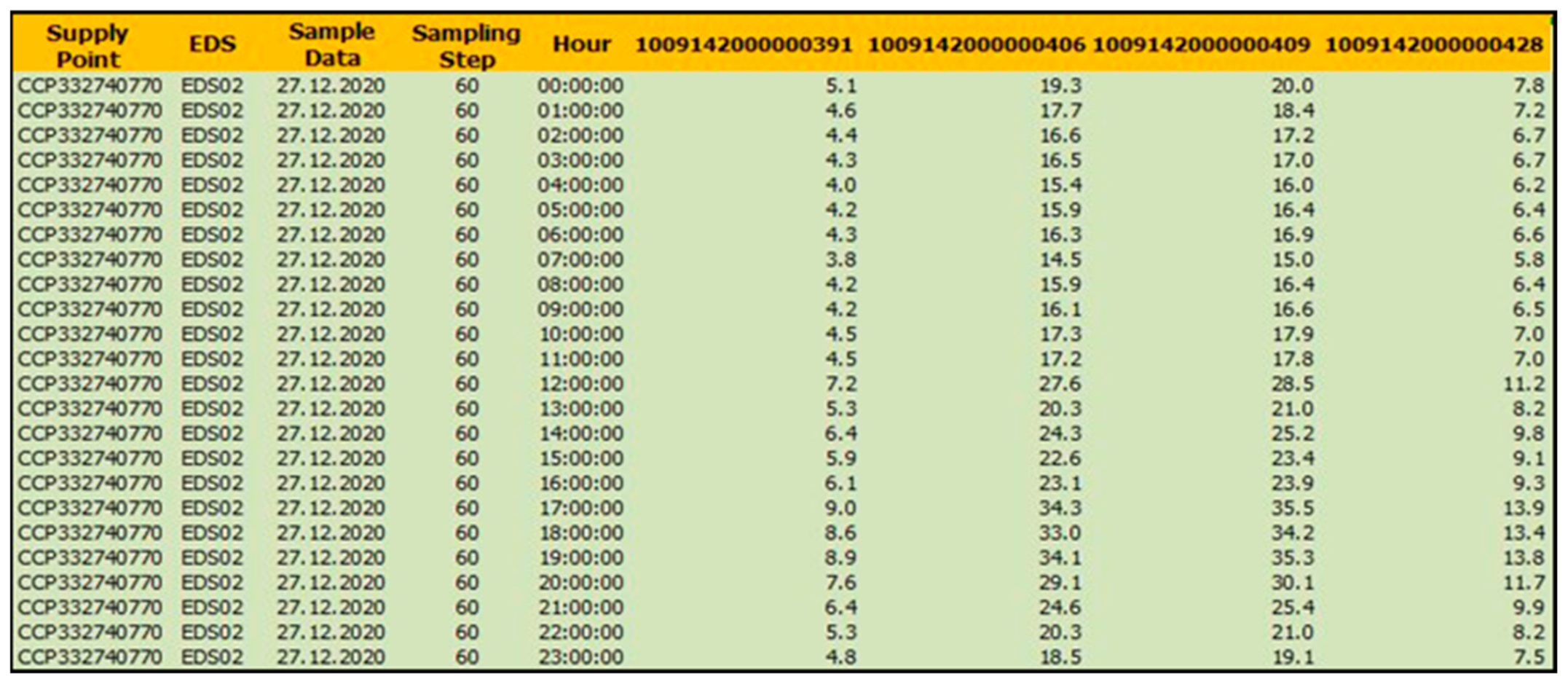
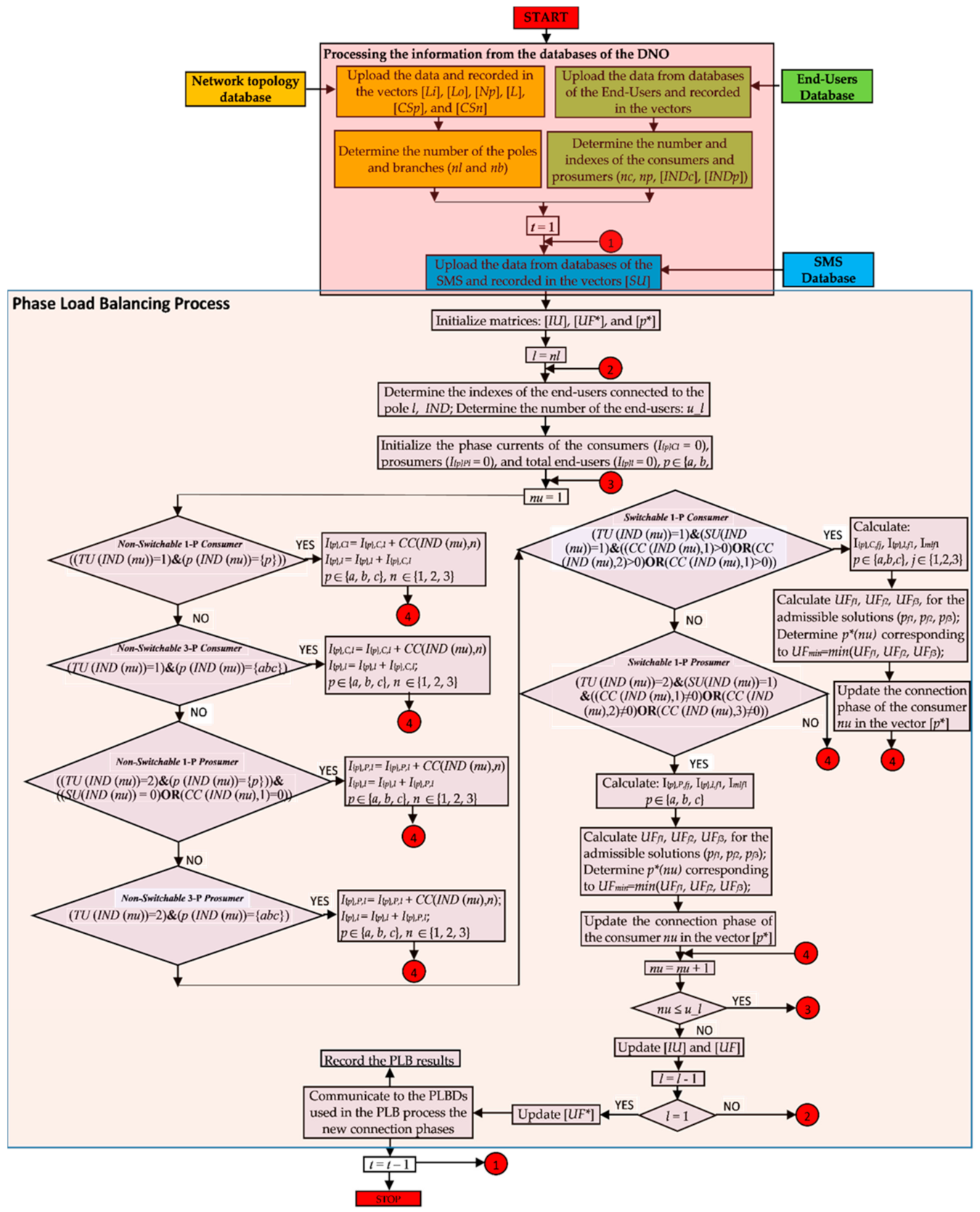



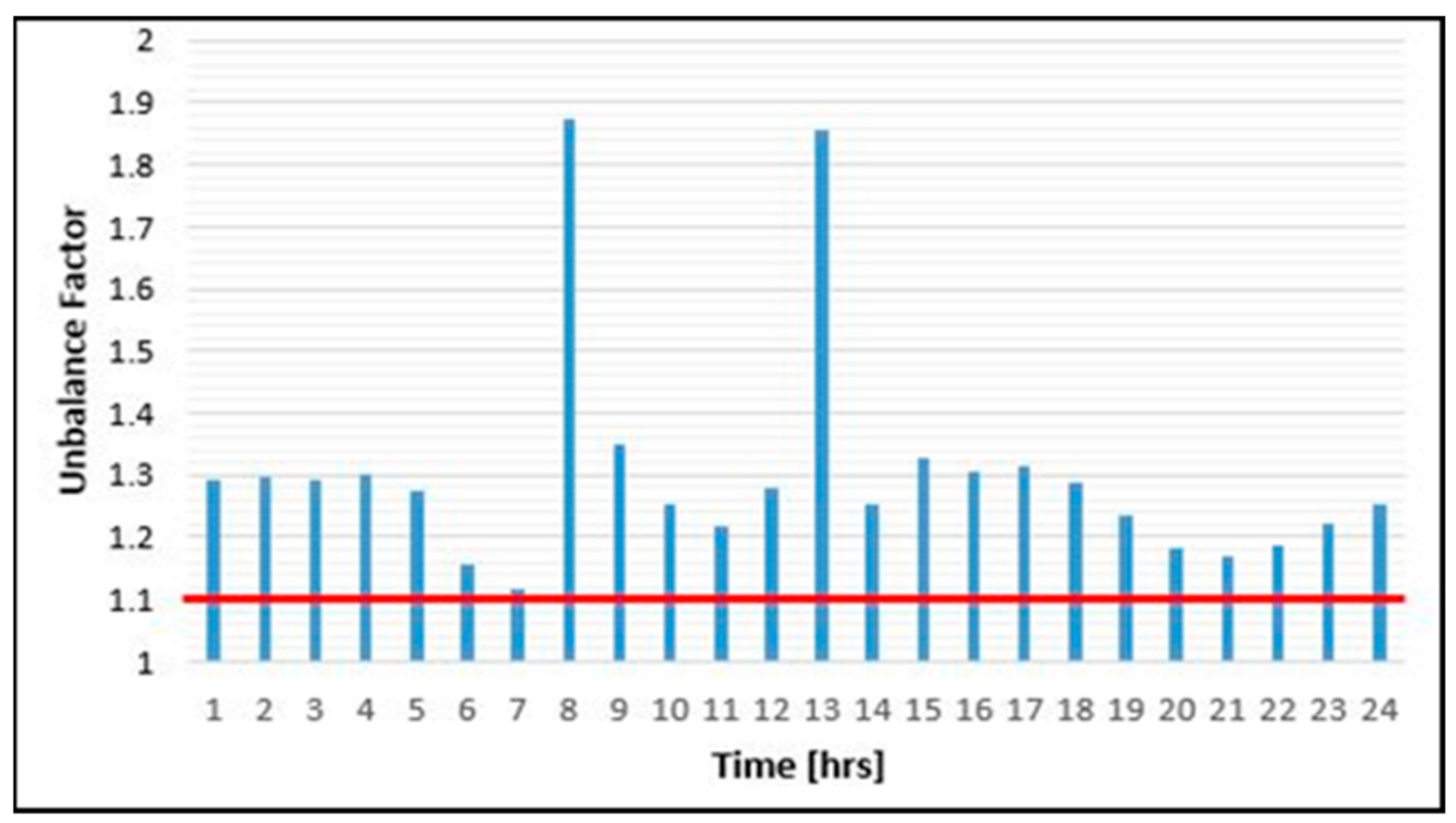
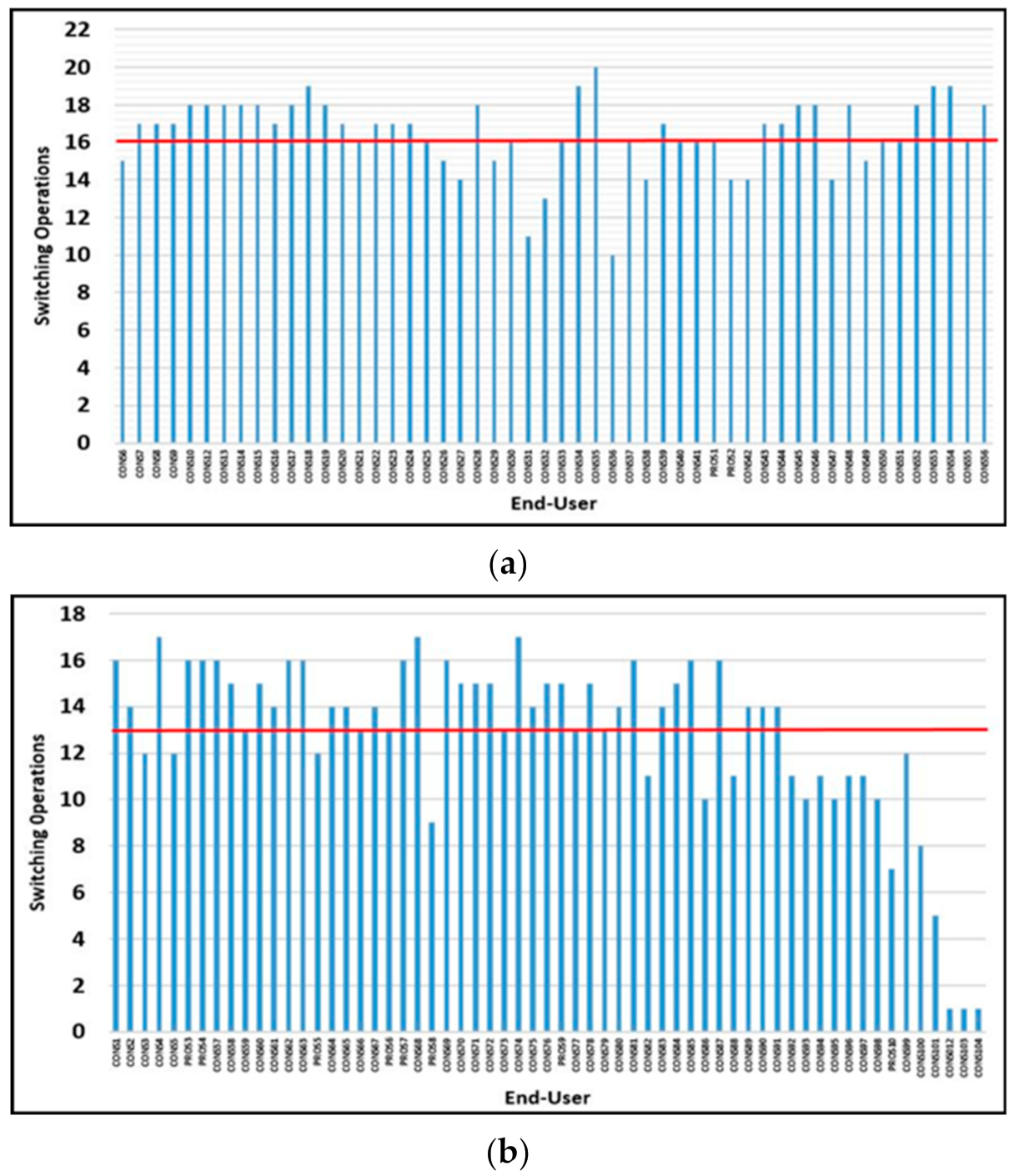

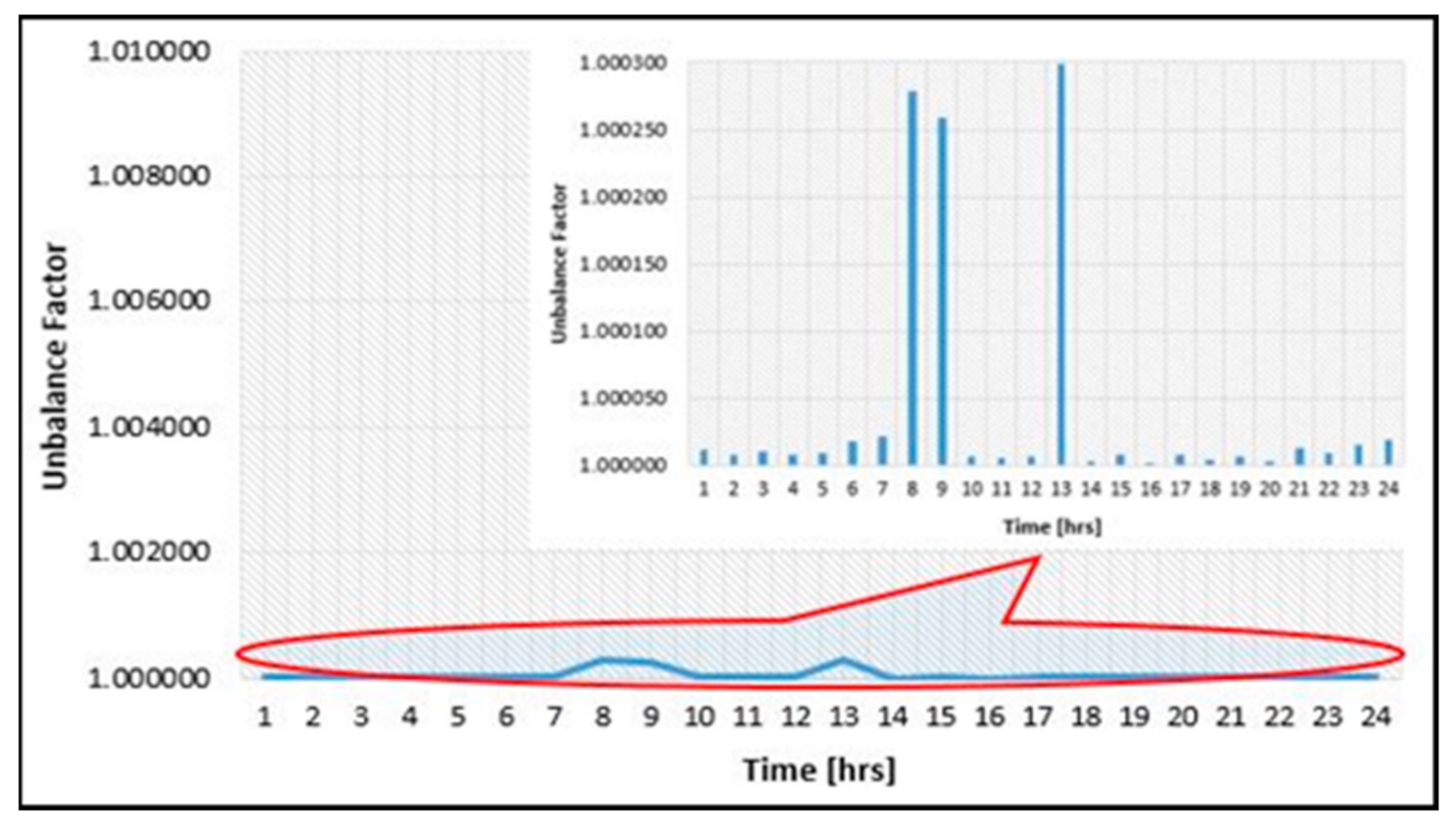

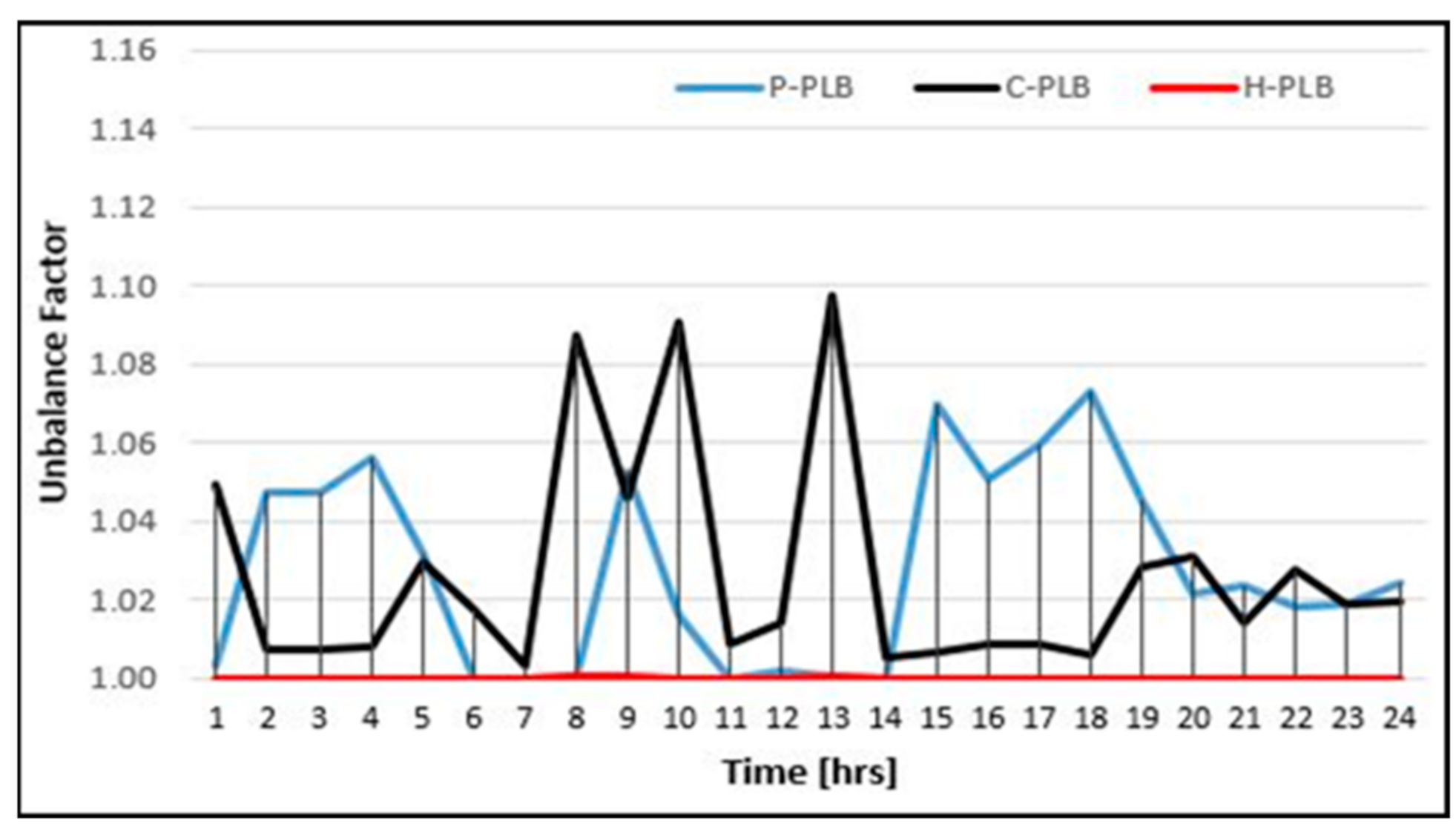
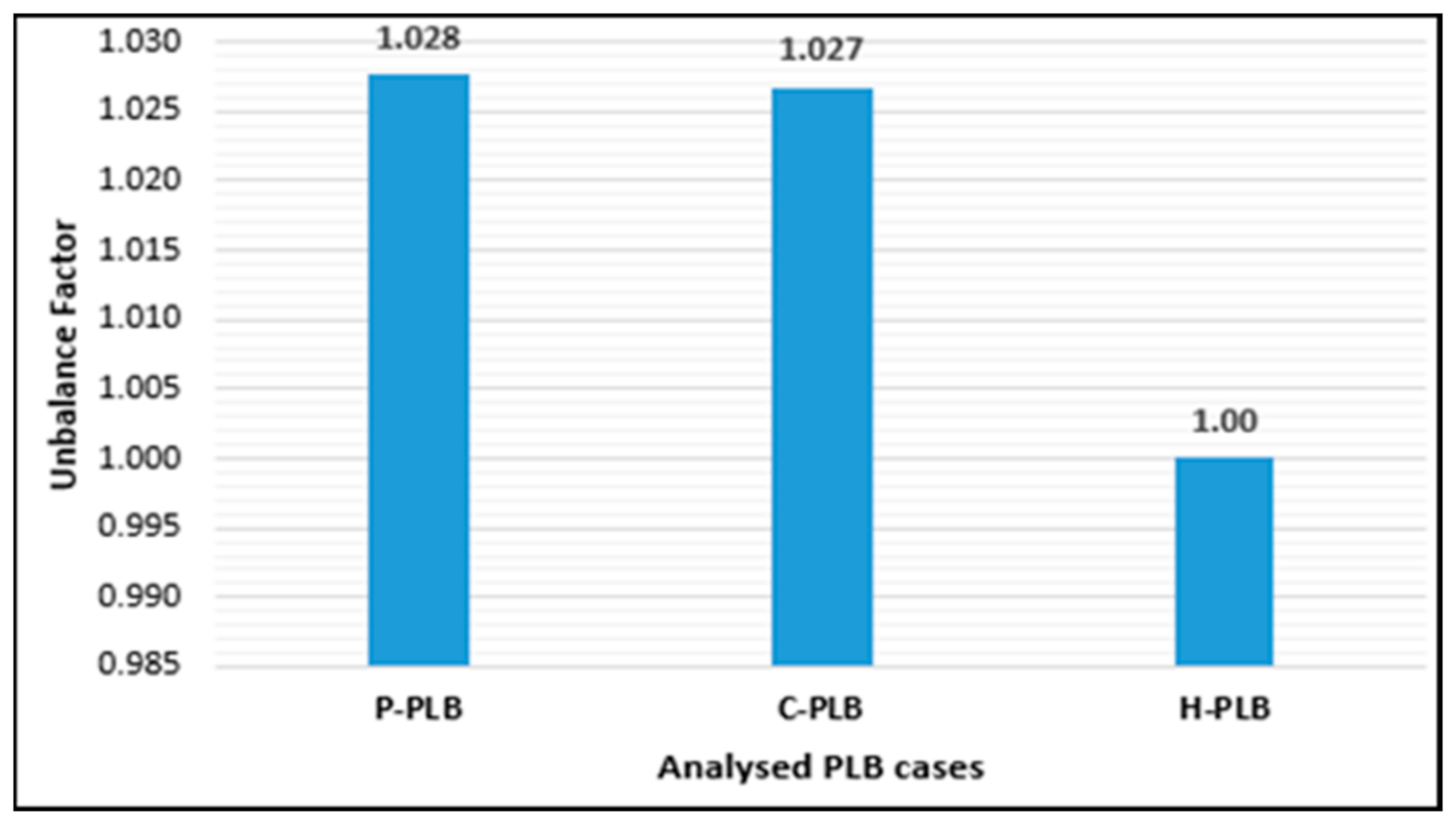
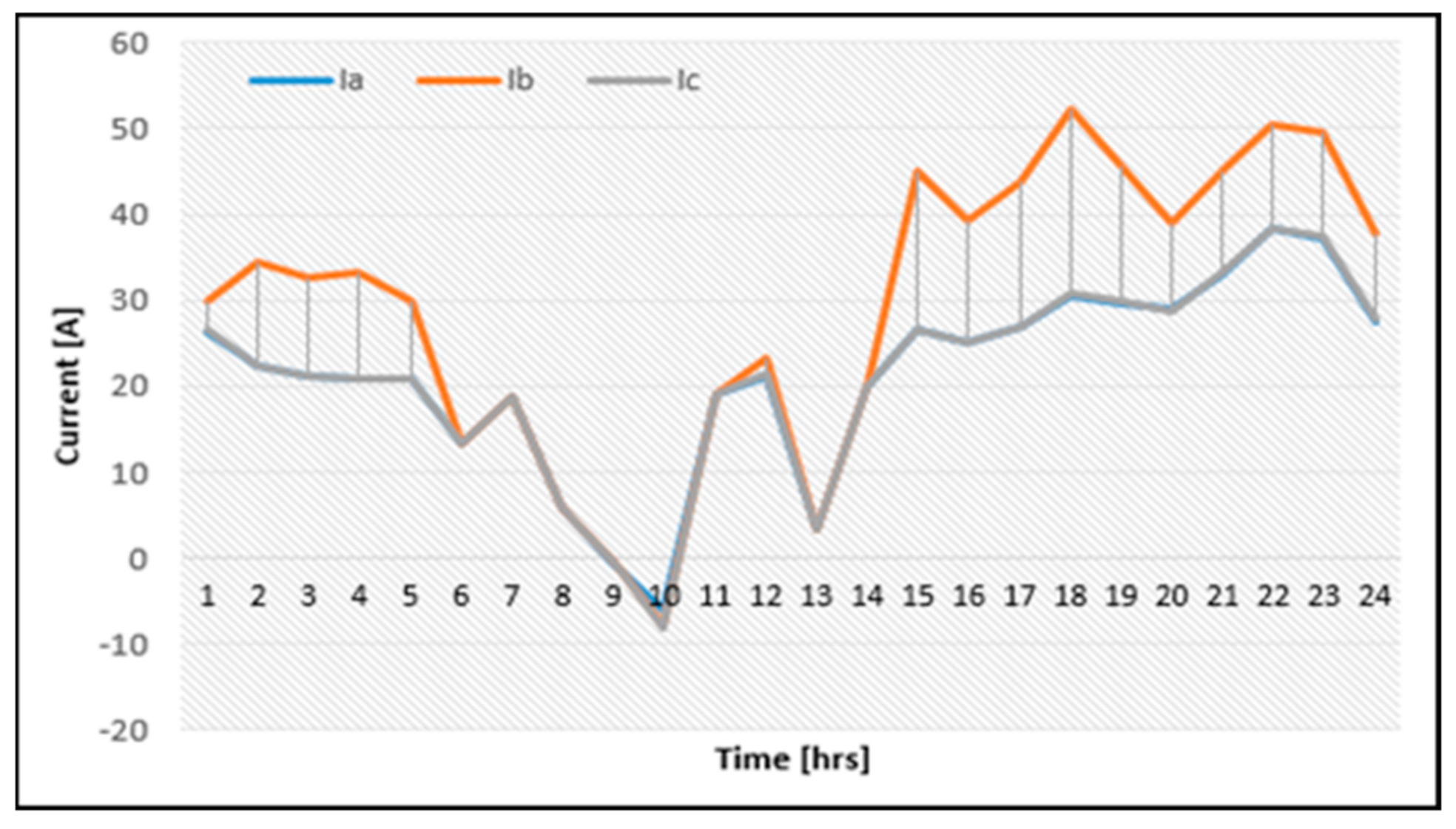
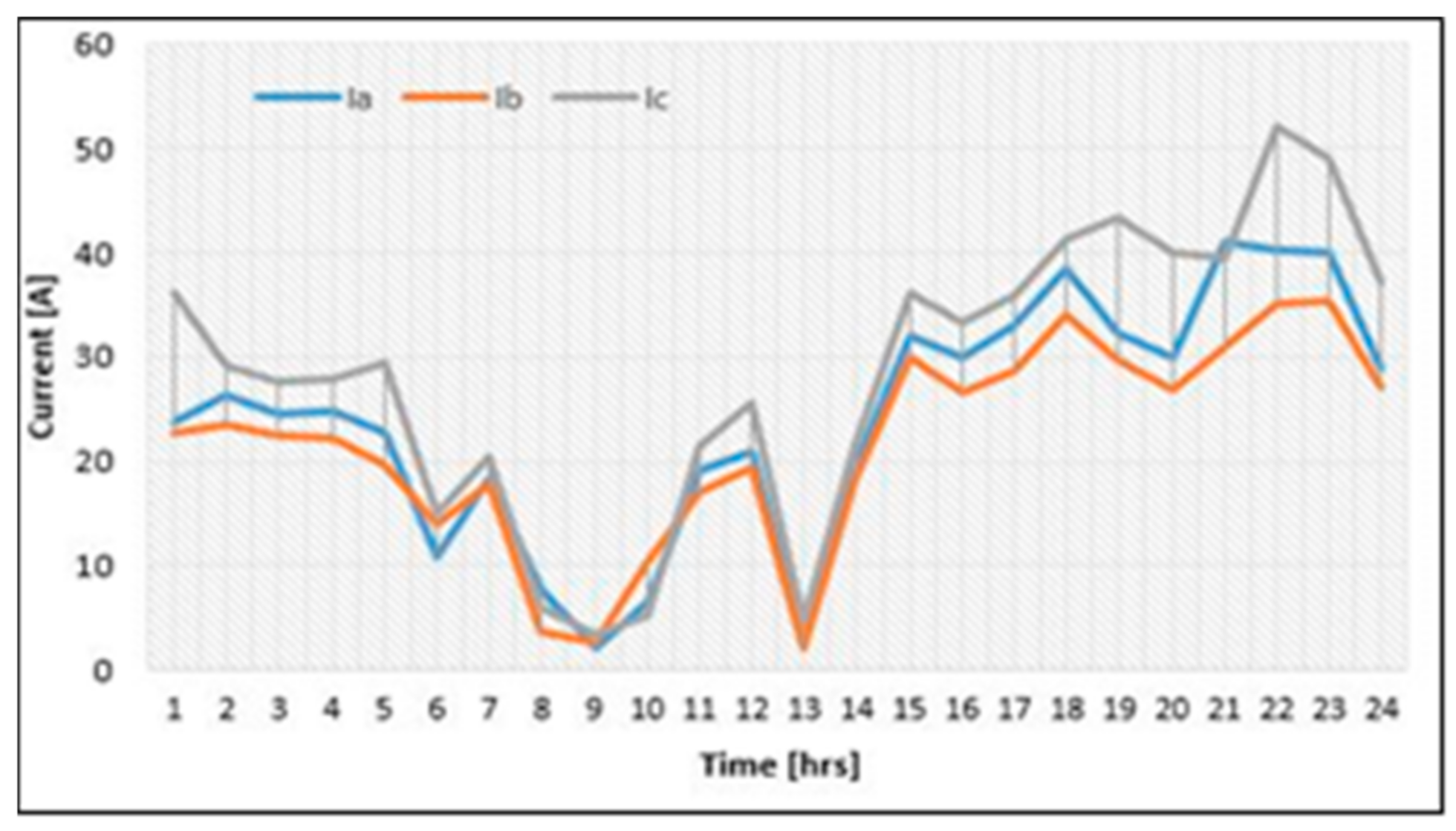
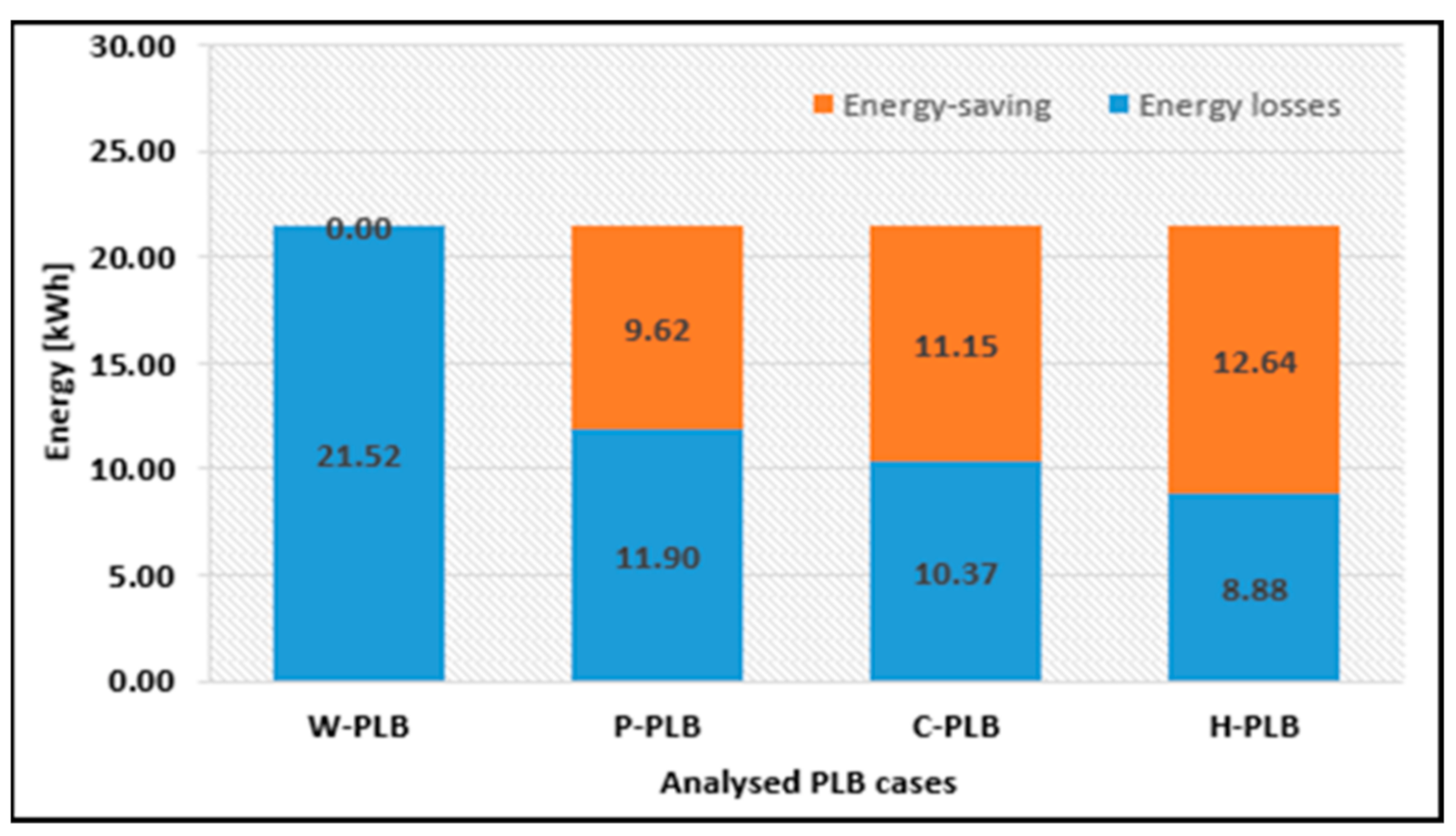
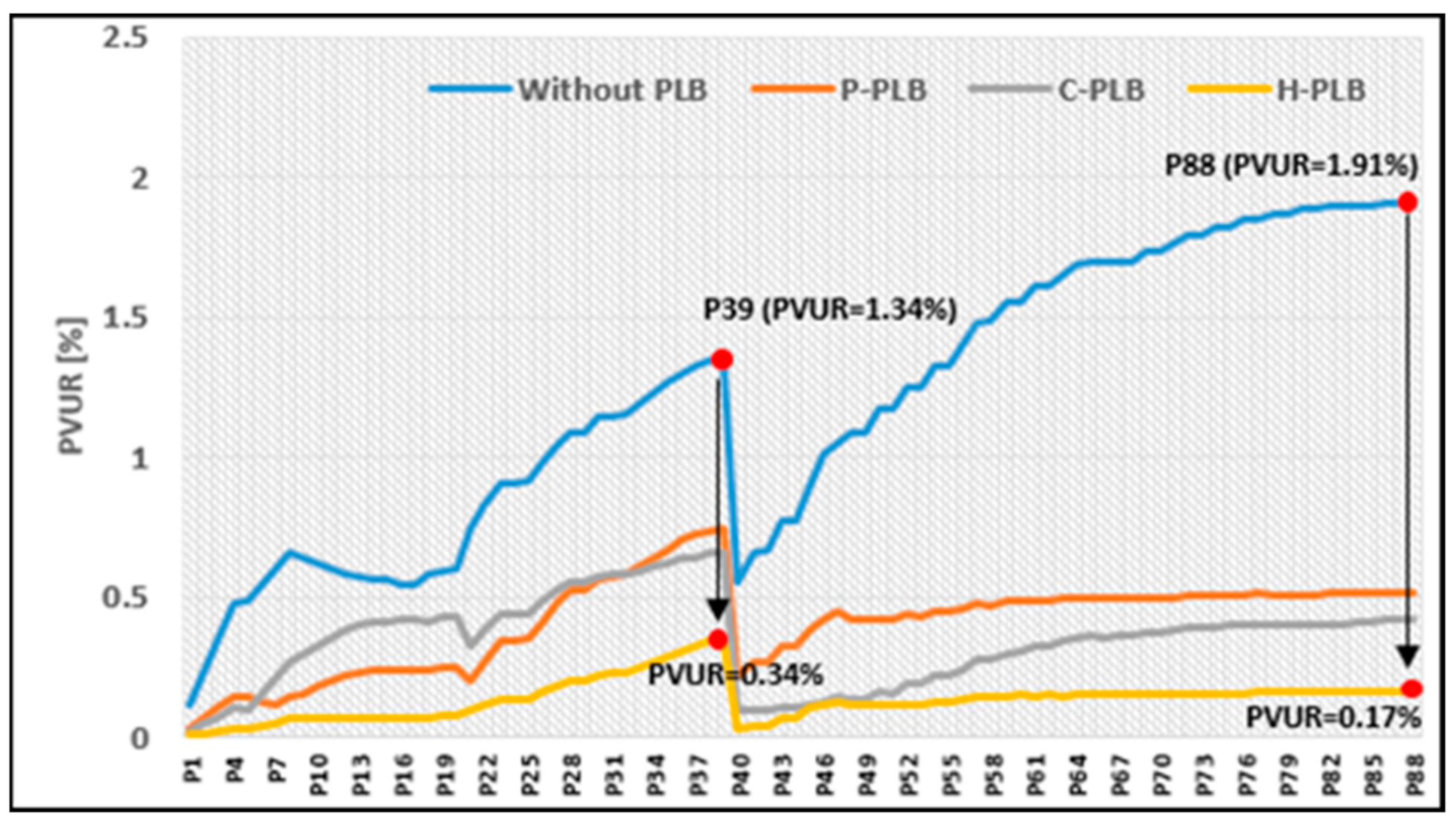
| References | Implementation Level of the PLB Solution | Testing | Implementation Possibility | ||
|---|---|---|---|---|---|
| Consumer | Prosumers | Real-Time | Offline | ||
| [16,18,21,22,23,24,33] | X | - | Test EDN | - | X |
| [17] | X | - | Laboratory configuration | - | X |
| [18,20] | X | - | Laboratory configuration | X | - |
| [19] | X | - | Real EDN | X | X |
| [29] | X | - | Real EDN | X | - |
| [25,26] | - | X | Real AEDN | X | X |
| [28,32] | - | X | Laboratory configuration | X | - |
| [30,31] | - | X | Real AEDN | - | X |
| [34,35] | - | X | Simulation | - | X |
| Consumer/Prosumer Type | Initial Positions | Final Positions |
|---|---|---|
| 1-P type | a b c | b/c/a c/a/b a/b/c |
| Stage 1. Identifying the topology of the AEDN |
Upload the data from the topology database and recorded in the vectors [L], [CS], [Np], [Li], and [Lo].
|
| Stage 2. Identifying the topology of the AEDN Querying the databases of the DNO (SMS and End-Users) |
Upload the data from databases of End-Users and recorded in the vectors [Nl], [p], [ID], and [TU].
|
| Stage 3. The PLB process implemented to the level of each pole: |
Calculate the total current on the phase a: Ial = Ial + IaCl;
Calculate the total current on the phase b: Ibl = Ibl + IbCl;
Calculate the total current on the phase c: Icl = Icl + IcCl; case Non-Switchable 3-P Consumer (the end-user nu is a 3-P consumer).
IaCl = IaCl + CC (IND (nu),1); IbCl = IbCl + CC (IND (nu),2); IcCl = IcCl + CC (IND (nu),3). Calculate the total current on all phases: Ial = Ial + IaCl; Ibl = Ibl + IbCl; Icl = Icl + IcCl. case Non-Switchable 1-P Prosumer (the end-user nu is a prosumer having the SSD with the status Off or the hourly injected/absorbed phase current with the null value).∙
Calculate the total current on the phase a: Ial = Ial + IaPl;
Calculate the total current on the phase b: Ibl = Ibl + IbPl;
Calculate the total current on the phase c: Icl = Icl + IcPl. case Non-Switchable 3-P Prosumer (the end-user nu is a 3-P prosumer).
IaPl = IaPl + CC (IND (nu),1); IbPl = IbPl + CC (IND (nu),2); IcPl = IcPl + CC (IND (nu),3). Calculate the total current on all phases: Ial = Ial + IaPl; Ibl = Ibl + IbPl; Icl = Icl + IcPl. case Switchable 1-P Consumer (the end-user nu is a consumer having the SSD with the status On and the hourly absorbed phase current with the positive value).
Identification of the optimal connection solution of the consumer nu using the combinatorial optimization: Admissible solution 1–connection on the phase a Determine the feasible phase currents: IaCf1 = IaCl + CC (IND (nu),1); IbCf1 = IbCl; IcCf1 = IcCl; Determine the feasible total phase currents: Ialf1 = Ial + IaCf1; Iblf1 = Ibl+ IbCf1; Iclf1 = Icl+ IcCf1; Determine the mean of the phase currents, Imlf1 (formula (2)); Determine the UFf1 (formula (1)). Admissible solution 2–connection on the phase b Determine the feasible phase currents: IaCf2 = IaCl; IbCf2 = Ibcl + CC (IND (nu), 2); IcCf2 = IcCl; Determine the feasible total phase currents: Ialf2 = Ial + IaCf2; Iblf2 = Ibl+ IbCf2; Iclf2 = Icl+ IcCf2; Determine the mean of the phase currents, Imlf2 (formula (2)); Determine the UFf2 (formula (1)). Admissible solution 3–connection on the phase c Determine the feasible phase currents: IaCf3 = IaCl; IbCf3 = IbCl; Iccf3 = IcCl + CC (IND (nu), 3); Determine the feasible total phase currents: Ialf3 = Ial + IaCf3; Iblf3 = Ibl+ IbCf3; Iclf3 = Icl+ IcCf3; Determine the mean of the phase currents, Imlf3 (formula (2)); Determine the UFf3 (formula (1)). Calculate the optimal solution that leads to the minimization of the UF: UFmin = min (UFf1, UFf2, UFf3); if Optimal solution = Admissible solution 1 Update the vector [p*]: p* (IND (nu)) = {a}; Update the total phase currents of consumers: IaCl = IaCf1; IbCl = IbCf1; IcCl = IcCf1; Update the total phase currents of the end-users: Ial = Ialf1; Ibl = Iblf1; Icl = Iclf1. if Optimal solution = Admissible solution 2 Update the vector [p*]: p* (IND (nu)) = {b}; Update the total phase currents of consumers: IaCl = IaCf2; IbCl = IbCf2; IcCl = IcCf2; Update the total phase currents of the end-users: Ial = Ialf2; Ibl = Iblf2; Icl = Iclf2. if Optimal solution = Admissible solution 2 Update the vector [p*]: p* (IND (nu)) = {c}; Update the total phase currents of prosumers: IaCl = IaCf3; IbCl = IbC3; IcCl = IcCf3; Update the total phase currents of the end-users: Ial = Ialf3; Ibl = Iblf3; Icl = Iclf3. case Switchable 1-P Prosumer (the end-user nu is a prosumer having the SSD with the status On and the hourly absorbed/injected phase current with the different value by 0).
Identification of the optimal connection solution of the prosumer nu using the combinatorial optimization: Admissible solution 1–connection on the phase a Determine the feasible phase currents: IaPf1 = IaPl + CC (IND (nu),1); IbPf1 = IbPl; IcPf1 = IcPl; Determine the feasible total phase currents: Ialf1 = Ial + IaPf1; Iblf1 = Ibl+ IbPf1; Iclf1 = Icl+ IcPf1; Determine the mean of the phase currents, Imlf1 (formula (2)); Determine the UFf1 (formula (1)). Admissible solution 2–connection on the phase b Determine the feasible phase currents: IaPf2 = IaPl; IbPf2 = IbPl + CC (IND (nu), 2); IcPf2 = IcPl; Determine the feasible total phase currents: Ialf2 = Ial + IaPf2; Iblf2 = Ibl+ IbPf2; Iclf2 = Icl+ IcPf2; Determine the mean of the phase currents, Imlf2 (formula (2)); Determine the UFf2 (formula (1)). Admissible solution 3–connection on the phase c Determine the feasible phase currents: IaPf3 = IaPl; IbPf3 = IbPl; IcPf3 = IcPl + CC (IND (nu), 3); Determine the feasible total phase currents: Ialf3 = Ial + IaPf3; Iblf3 = Ibl+ IbPf3; Iclf3 = Icl+ IcPf3; Determine the mean of the phase currents, Imlf3 (formula (2)); Determine the UFf3 (formula (1)). Calculate the optimal solution that leads to the minimization of the UF: UFmin = min (UFf1, UFf2, UFf3); if Optimal solution = Admissible solution 1 Update the vector [p*]: p* (IND (nu)) = {a}; Update the total phase currents of prosumers: IaPl = IaPf1; IbPl = Ibpf1; IcPl = IcPf1; Update the total phase currents of the end-users: Ial = Ialf1; Ibl = Iblf1; Icl = Iclf1. if Optimal solution = Admissible solution 2 Update the vector [p*]: p* (IND (nu)) = {b}; Update the total phase currents of prosumers: IaPl = IaPf2; IbPl = IbPf2; IcPl = IcPf2; Update the total phase currents of the end-users: Ial = Ialf2; Ibl = Iblf2; Icl = Iclf2. if Optimal solution = Admissible solution 3 Update the vector [p*]: p* (IND (nu)) = {c}; Update the total phase currents of prosumers: IaPl = IaPf3; IbPl = IbPf3; IcPl = IcPf3; Update the total phase currents of the end-users: Ial = Ialf3; Ibl = Iblf3; Icl = Iclf3.
Print the results. |
| AEDN | Number of Poles | Pole i | Pole j | Length (km) | Cross-Section (mm2) | Consumers/ Prosumers | |
|---|---|---|---|---|---|---|---|
| Phase | Neutral | ||||||
| Main trunk (MT) | 53 | CCP | P5 | 0.20 | 3 × 50 | 50 | 5 |
| P5 | P66 | 1.08 | 3 × 50 | 50 | 28/7 | ||
| P66 | P88 | 0.80 | 3 × 50 | 50 | 19/1 | ||
| P66 | P68 | 0.08 | 1 × 16 | 25 | 1 | ||
| Lateral branch (LB) | 35 | P5 | P13 | 0.32 | 3 × 35 | 35 | 11 |
| P13 | P20 | 0.28 | 1 × 35 | 35 | 6 | ||
| P8 | P32 | 0.48 | 3 × 35 | 35 | 22/2 | ||
| P29 | P39 | 0.28 | 1 × 25 | 25 | 12 | ||
| End-User | Branch | Pole | Phase | End-User | Branch | Pole | Phase | End-User | Branch | Pole | Phase |
|---|---|---|---|---|---|---|---|---|---|---|---|
| CONS1 | MT | P1 | Phase b | CONS83 | MT | P63 | Phase b | CONS21 | LB | P20 | Phase c |
| CONS2 | MT | P2 | Phase a | CONS84 | MT | P65 | Phase b | CONS22 | LB | P20 | Phase c |
| CONS3 | MT | P3 | Phase b | CONS85 | MT | P68 | Phase b | CONS23 | LB | P21 | Phase b |
| CONS4 | MT | P4 | Phase b | CONS86 | MT | P70 | Phase b | CONS24 | LB | P21 | Phase c |
| CONS5 | MT | P5 | Phase b | CONS87 | MT | P71 | Phase a | CONS25 | LB | P22 | Phase c |
| PROS3 | MT | P40 | Phase b | CONS88 | MT | P71 | Phase b | CONS26 | LB | P22 | Phase c |
| PROS4 | MT | P40 | Phase b | CONS89 | MT | P71 | Phase b | CONS27 | LB | P23 | Phase c |
| CONS57 | MT | P41 | Phase a | CONS90 | MT | P71 | Phase b | CONS28 | LB | P23 | Phase c |
| CONS58 | MT | P41 | Phase b | CONS91 | MT | P72 | Phase b | CONS29 | LB | P24 | Phase c |
| CONS59 | MT | P41 | Phase b | CONS92 | MT | P73 | Phase b | CONS30 | LB | P25 | Phase c |
| CONS60 | MT | P42 | Phase b | CONS93 | MT | P75 | Phase b | CONS31 | LB | P26 | Phase c |
| CONS61 | MT | P42 | Phase b | CONS94 | MT | P75 | Phase b | CONS32 | LB | P26 | Phase c |
| CONS62 | MT | P43 | Phase c | CONS95 | MT | P76 | Phase a | CONS33 | LB | P26 | Phase c |
| CONS63 | MT | P45 | Phase b | CONS96 | MT | P77 | Phase b | CONS34 | LB | P26 | Phase c |
| PROS5 | MT | P45 | Phase b | CONS97 | MT | P80 | Phase b | CONS35 | LB | P27 | Phase c |
| CONS64 | MT | P46 | Phase b | CONS98 | MT | P80 | Phase b | CONS36 | LB | P27 | Phase c |
| CONS65 | MT | P47 | Phase b | PROS10 | MT | P81 | Phase b | CONS37 | LB | P27 | Phase a |
| CONS66 | MT | P47 | Phase b | CONS99 | MT | P82 | Phase b | CONS38 | LB | P28 | Phase a |
| CONS67 | MT | P47 | Phase b | CONS100 | MT | P82 | Phase b | CONS39 | LB | P28 | Phase c |
| PROS6 | MT | P47 | Phase b | CONS101 | MT | P85 | Phase b | CONS40 | LB | P28 | Phase c |
| PROS7 | MT | P47 | Phase b | CONS012 | MT | P86 | Phase b | CONS41 | LB | P30 | Phase c |
| CONS68 | MT | P48 | Phase b | CONS103 | MT | P86 | Phase b | PROS1 | LB | P30 | Phase a |
| PROS8 | MT | P51 | Phase a | CONS104 | MT | P88 | Phase b | PROS2 | LB | P30 | Phase c |
| CONS69 | MT | P52 | Phase b | CONS6 | LB | P6 | Phase b | CONS42 | LB | P31 | Phase c |
| CONS70 | MT | P52 | Phase b | CONS7 | LB | P6 | Phase c | CONS43 | LB | P32 | Phase c |
| CONS71 | MT | P53 | Phase b | CONS8 | LB | P7 | Phase c | CONS44 | LB | P32 | Phase c |
| CONS72 | MT | P55 | Phase c | CONS9 | LB | P8 | Phase b | CONS45 | LB | P33 | Phase c |
| CONS73 | MT | P56 | Phase a | CONS10 | LB | P9 | Phase c | CONS46 | LB | P33 | Phase c |
| CONS74 | MT | P58 | Phase b | CONS11 | LB | P10 | Phase abc | CONS47 | LB | P34 | Phase c |
| CONS75 | MT | P59 | Phase a | CONS12 | LB | P11 | Phase c | CONS48 | LB | P35 | Phase c |
| CONS76 | MT | P59 | Phase b | CONS13 | LB | P11 | Phase c | CONS49 | LB | P36 | Phase c |
| PROS9 | MT | P59 | Phase b | CONS14 | LB | P12 | Phase a | CONS50 | LB | P36 | Phase c |
| CONS77 | MT | P60 | Phase b | CONS15 | LB | P13 | Phase a | CONS51 | LB | P37 | Phase c |
| CONS78 | MT | P60 | Phase b | CONS16 | LB | P13 | Phase a | CONS52 | LB | P37 | Phase b |
| CONS79 | MT | P61 | Phase b | CONS17 | LB | P16 | Phase a | CONS53 | LB | P38 | Phase c |
| CONS80 | MT | P61 | Phase b | CONS18 | LB | P16 | Phase a | CONS54 | LB | P38 | Phase c |
| CONS81 | MT | P62 | Phase a | CONS19 | LB | P19 | Phase c | CONS55 | LB | P38 | Phase c |
| CONS82 | MT | P62 | Phase b | CONS20 | LB | P19 | Phase c | CONS56 | LB | P39 | Phase c |
| No. | PLB Algorithms | Computational Times [Seconds] |
|---|---|---|
| 1 | H-PLBA (Proposed) | 1.13 |
| 2 | HA-PSPL [15] | 1.26 |
| 4 | AG-PSSL [42] | 291 |
| 3 | PSO-PSSL [43] | 348 |
| Hour | W-PLB | P-PLB | C-PLB | H-PLB | ||||||||||||
|---|---|---|---|---|---|---|---|---|---|---|---|---|---|---|---|---|
| Ia | Ib | Ic | UF | Ia | Ib | Ic | UF | Ia | Ib | Ic | UF | Ia | Ib | Ic | UF | |
| H1 | 14.75 | 48.48 | 19.44 | 1.29 | 26.36 | 29.86 | 26.46 | 1.003 | 23.69 | 22.78 | 36.20 | 1.049 | 27.68 | 27.51 | 27.47 | 1.00001 |
| H2 | 13.99 | 46.35 | 18.61 | 1.29 | 22.26 | 34.44 | 22.25 | 1.048 | 26.27 | 23.56 | 29.11 | 1.007 | 26.42 | 26.24 | 26.29 | 1.00001 |
| H3 | 13.22 | 43.63 | 17.70 | 1.29 | 20.99 | 32.52 | 21.04 | 1.048 | 24.57 | 22.34 | 27.63 | 1.008 | 24.96 | 24.78 | 24.81 | 1.00001 |
| H4 | 13.35 | 44.21 | 17.42 | 1.30 | 20.79 | 33.37 | 20.81 | 1.056 | 24.91 | 22.28 | 27.79 | 1.008 | 25.09 | 24.94 | 24.95 | 1.00001 |
| H5 | 12.76 | 41.49 | 17.60 | 1.27 | 20.93 | 29.99 | 20.92 | 1.032 | 22.71 | 19.65 | 29.49 | 1.029 | 23.95 | 23.86 | 24.04 | 1.00001 |
| H6 | 6.49 | 19.18 | 14.24 | 1.15 | 13.32 | 13.24 | 13.35 | 1.000 | 10.90 | 13.91 | 15.09 | 1.018 | 13.28 | 13.38 | 13.25 | 1.00002 |
| H7 | 11.84 | 27.22 | 17.21 | 1.12 | 18.81 | 18.66 | 18.80 | 1.000 | 18.25 | 17.73 | 20.30 | 1.003 | 18.81 | 18.64 | 18.83 | 1.00002 |
| H8 | 3.97 | −0.38 | 13.73 | 1.87 | 5.81 | 5.87 | 5.64 | 1.000 | 7.80 | 3.63 | 5.88 | 1.087 | 5.64 | 5.81 | 5.87 | 1.00028 |
| H9 | −1.41 | −11.89 | 12.12 | 1.35 | −0.50 | −0.28 | −0.39 | 1.052 | 2.14 | 2.59 | 3.55 | 1.046 | 0.31 | 0.31 | 0.30 | 1.00026 |
| H10 | −8.24 | −23.45 | 9.54 | 1.25 | −6.06 | −7.99 | −8.10 | 1.016 | 6.51 | 10.43 | 5.21 | 1.090 | 7.36 | 7.37 | 7.41 | 1.00001 |
| H11 | 8.65 | 30.45 | 18.25 | 1.22 | 19.16 | 19.08 | 19.12 | 1.000 | 19.00 | 17.04 | 21.32 | 1.008 | 19.15 | 19.06 | 19.15 | 1.00000 |
| H12 | 10.59 | 37.93 | 17.34 | 1.28 | 21.16 | 23.35 | 21.36 | 1.002 | 20.85 | 19.48 | 25.54 | 1.014 | 21.90 | 22.03 | 21.94 | 1.00001 |
| H13 | −2.81 | 0.84 | 11.79 | 1.86 | 3.26 | 3.20 | 3.36 | 1.000 | 2.97 | 2.20 | 4.65 | 1.097 | 3.27 | 3.21 | 3.35 | 1.00030 |
| H14 | 8.62 | 32.81 | 18.05 | 1.25 | 19.78 | 19.84 | 19.86 | 1.000 | 19.54 | 18.29 | 21.65 | 1.005 | 19.82 | 19.79 | 19.86 | 1.00000 |
| H15 | 17.25 | 58.91 | 21.88 | 1.33 | 26.55 | 44.87 | 26.62 | 1.070 | 31.91 | 29.97 | 36.16 | 1.006 | 32.80 | 32.62 | 32.61 | 1.00001 |
| H16 | 15.64 | 52.93 | 21.03 | 1.30 | 25.01 | 39.38 | 25.21 | 1.051 | 29.83 | 26.50 | 33.26 | 1.009 | 29.83 | 29.89 | 29.87 | 1.00000 |
| H17 | 17.48 | 58.20 | 22.08 | 1.31 | 26.93 | 43.85 | 26.98 | 1.060 | 33.13 | 28.67 | 35.96 | 1.008 | 32.71 | 32.54 | 32.51 | 1.00001 |
| H18 | 21.50 | 66.45 | 25.74 | 1.29 | 30.60 | 52.35 | 30.74 | 1.073 | 38.49 | 34.04 | 41.16 | 1.006 | 37.94 | 37.96 | 37.80 | 1.00000 |
| H19 | 21.27 | 58.94 | 25.08 | 1.23 | 29.72 | 45.66 | 29.91 | 1.045 | 32.27 | 29.74 | 43.28 | 1.028 | 35.19 | 34.98 | 35.12 | 1.00001 |
| H20 | 21.23 | 51.61 | 23.72 | 1.18 | 28.91 | 38.88 | 28.77 | 1.022 | 29.83 | 26.74 | 39.98 | 1.031 | 32.11 | 32.25 | 32.20 | 1.00000 |
| H21 | 25.60 | 58.45 | 27.01 | 1.17 | 32.91 | 45.02 | 33.13 | 1.023 | 40.88 | 30.87 | 39.32 | 1.014 | 36.86 | 37.18 | 37.03 | 1.00001 |
| H22 | 27.62 | 68.09 | 31.47 | 1.19 | 38.28 | 50.47 | 38.43 | 1.018 | 40.18 | 35.07 | 51.94 | 1.028 | 42.56 | 42.24 | 42.38 | 1.00001 |
| H23 | 24.77 | 68.72 | 30.58 | 1.22 | 37.30 | 49.44 | 37.33 | 1.019 | 39.93 | 35.23 | 48.90 | 1.019 | 41.25 | 41.23 | 41.58 | 1.00002 |
| H24 | 17.09 | 52.92 | 23.12 | 1.25 | 27.59 | 37.86 | 27.67 | 1.024 | 29.00 | 27.08 | 37.05 | 1.019 | 30.91 | 30.99 | 31.22 | 1.00002 |
| Case | UFav | ΔW (kWh) | ESPLB | |
|---|---|---|---|---|
| (kWh) | (%) | |||
| W-PLB | 1.260 | 21.52 | - | - |
| P-PLB | 1.028 | 11.90 | 9.62 | 44.70 |
| C-PLB | 1.027 | 10.37 | 11.15 | 51.82 |
| H–PLB | 1.000 | 8.88 | 12.64 | 58.73 |
| Hour | PLB Cases | Hour | PLB Cases | ||||||
|---|---|---|---|---|---|---|---|---|---|
| W-PLB | P-PLB | C-PLB | H-PLB | W-PLB | P-PLB | C-PLB | H-PLB | ||
| H1 | 0.89 | 0.46 | 0.44 | 0.37 | H13 | 0.19 | 0.18 | 0.15 | 0.10 |
| H2 | 0.81 | 0.43 | 0.37 | 0.32 | H14 | 0.50 | 0.27 | 0.29 | 0.22 |
| H3 | 0.72 | 0.37 | 0.33 | 0.29 | H15 | 1.28 | 0.67 | 0.56 | 0.49 |
| H4 | 0.73 | 0.38 | 0.33 | 0.29 | H16 | 1.05 | 0.55 | 0.48 | 0.42 |
| H5 | 0.66 | 0.34 | 0.31 | 0.27 | H17 | 1.26 | 0.67 | 0.56 | 0.50 |
| H6 | 0.23 | 0.11 | 0.16 | 0.10 | H18 | 1.69 | 0.91 | 0.75 | 0.67 |
| H7 | 0.40 | 0.19 | 0.24 | 0.18 | H19 | 1.40 | 0.75 | 0.64 | 0.57 |
| H8 | 0.20 | 0.19 | 0.14 | 0.09 | H20 | 1.14 | 0.59 | 0.55 | 0.49 |
| H9 | 0.27 | 0.33 | 0.15 | 0.10 | H21 | 1.50 | 0.79 | 0.72 | 0.65 |
| H10 | 0.42 | 0.52 | 0.22 | 0.18 | H22 | 2.03 | 1.04 | 0.98 | 0.87 |
| H11 | 0.47 | 0.33 | 0.29 | 0.21 | H23 | 1.99 | 0.99 | 0.91 | 0.83 |
| H12 | 0.58 | 0.28 | 0.30 | 0.23 | H24 | 1.12 | 0.56 | 0.51 | 0.45 |
| Pole | PLB Cases | Pole | PLB Cases | ||||||
|---|---|---|---|---|---|---|---|---|---|
| W-PLB | P-PLB | C-PLB | H-PLB | W-PLB | P-PLB | C-PLB | H-PLB | ||
| P1 | 0.11 | 0.03 | 0.02 | 0.01 | P45 | 0.90 | 0.38 | 0.12 | 0.10 |
| P2 | 0.23 | 0.07 | 0.05 | 0.01 | P46 | 1.01 | 0.42 | 0.13 | 0.11 |
| P3 | 0.34 | 0.10 | 0.07 | 0.02 | P47 | 1.05 | 0.45 | 0.14 | 0.12 |
| P4 | 0.48 | 0.15 | 0.10 | 0.03 | P48 | 1.09 | 0.42 | 0.14 | 0.11 |
| P5 | 0.48 | 0.15 | 0.10 | 0.03 | P49 | 1.09 | 0.42 | 0.14 | 0.11 |
| P6 | 0.54 | 0.12 | 0.15 | 0.04 | P50 | 1.17 | 0.42 | 0.16 | 0.11 |
| P7 | 0.60 | 0.11 | 0.21 | 0.05 | P51 | 1.17 | 0.42 | 0.16 | 0.11 |
| P8 | 0.66 | 0.14 | 0.27 | 0.07 | P52 | 1.25 | 0.44 | 0.19 | 0.12 |
| P9 | 0.64 | 0.16 | 0.30 | 0.07 | P53 | 1.25 | 0.43 | 0.19 | 0.12 |
| P10 | 0.62 | 0.18 | 0.33 | 0.07 | P54 | 1.32 | 0.45 | 0.22 | 0.12 |
| P11 | 0.61 | 0.20 | 0.36 | 0.07 | P55 | 1.32 | 0.45 | 0.22 | 0.12 |
| P12 | 0.58 | 0.22 | 0.38 | 0.07 | P56 | 1.40 | 0.46 | 0.24 | 0.13 |
| P13 | 0.57 | 0.23 | 0.40 | 0.07 | P57 | 1.48 | 0.47 | 0.27 | 0.14 |
| P14 | 0.56 | 0.24 | 0.41 | 0.07 | P58 | 1.49 | 0.47 | 0.28 | 0.14 |
| P15 | 0.56 | 0.24 | 0.41 | 0.07 | P59 | 1.55 | 0.49 | 0.30 | 0.15 |
| P16 | 0.55 | 0.24 | 0.42 | 0.07 | P60 | 1.56 | 0.49 | 0.30 | 0.15 |
| P17 | 0.55 | 0.24 | 0.42 | 0.07 | P61 | 1.61 | 0.49 | 0.32 | 0.15 |
| P18 | 0.58 | 0.24 | 0.42 | 0.07 | P62 | 1.61 | 0.49 | 0.32 | 0.15 |
| P19 | 0.60 | 0.25 | 0.43 | 0.08 | P63 | 1.65 | 0.49 | 0.34 | 0.15 |
| P20 | 0.60 | 0.25 | 0.43 | 0.08 | P64 | 1.69 | 0.50 | 0.36 | 0.15 |
| P21 | 0.74 | 0.20 | 0.33 | 0.09 | P65 | 1.69 | 0.50 | 0.36 | 0.15 |
| P22 | 0.83 | 0.27 | 0.38 | 0.11 | P66 | 1.69 | 0.50 | 0.36 | 0.15 |
| P23 | 0.91 | 0.35 | 0.44 | 0.14 | P67 | 1.70 | 0.50 | 0.36 | 0.15 |
| P24 | 0.91 | 0.35 | 0.44 | 0.14 | P68 | 1.70 | 0.50 | 0.36 | 0.15 |
| P25 | 0.91 | 0.35 | 0.44 | 0.14 | P69 | 1.73 | 0.50 | 0.37 | 0.15 |
| P26 | 0.98 | 0.41 | 0.49 | 0.16 | P70 | 1.73 | 0.50 | 0.37 | 0.15 |
| P27 | 1.04 | 0.47 | 0.52 | 0.18 | P71 | 1.77 | 0.50 | 0.38 | 0.15 |
| P28 | 1.09 | 0.52 | 0.55 | 0.20 | P72 | 1.79 | 0.50 | 0.39 | 0.15 |
| P29 | 1.09 | 0.52 | 0.55 | 0.20 | P73 | 1.79 | 0.50 | 0.39 | 0.15 |
| P30 | 1.14 | 0.57 | 0.57 | 0.22 | P74 | 1.82 | 0.51 | 0.39 | 0.16 |
| P31 | 1.15 | 0.57 | 0.58 | 0.23 | P75 | 1.82 | 0.51 | 0.40 | 0.16 |
| P32 | 1.15 | 0.58 | 0.58 | 0.23 | P76 | 1.84 | 0.51 | 0.40 | 0.16 |
| P33 | 1.19 | 0.61 | 0.60 | 0.25 | P77 | 1.85 | 0.51 | 0.40 | 0.16 |
| P34 | 1.23 | 0.64 | 0.61 | 0.27 | P78 | 1.86 | 0.51 | 0.40 | 0.16 |
| P35 | 1.26 | 0.67 | 0.62 | 0.29 | P79 | 1.86 | 0.51 | 0.40 | 0.16 |
| P36 | 1.30 | 0.70 | 0.64 | 0.31 | P80 | 1.88 | 0.51 | 0.40 | 0.16 |
| P37 | 1.33 | 0.73 | 0.64 | 0.33 | P81 | 1.89 | 0.51 | 0.40 | 0.16 |
| P38 | 1.34 | 0.74 | 0.66 | 0.34 | P82 | 1.89 | 0.51 | 0.41 | 0.17 |
| P39 | 1.34 | 0.74 | 0.66 | 0.34 | P83 | 1.89 | 0.51 | 0.41 | 0.17 |
| P40 | 0.55 | 0.22 | 0.10 | 0.03 | P84 | 1.90 | 0.51 | 0.41 | 0.17 |
| P41 | 0.66 | 0.27 | 0.10 | 0.04 | P85 | 1.90 | 0.51 | 0.41 | 0.17 |
| P42 | 0.67 | 0.27 | 0.10 | 0.04 | P86 | 1.90 | 0.51 | 0.42 | 0.17 |
| P43 | 0.78 | 0.33 | 0.11 | 0.07 | P87 | 1.90 | 0.51 | 0.42 | 0.17 |
| P44 | 0.78 | 0.33 | 0.11 | 0.07 | P88 | 1.91 | 0.51 | 0.42 | 0.17 |
Publisher’s Note: MDPI stays neutral with regard to jurisdictional claims in published maps and institutional affiliations. |
© 2021 by the authors. Licensee MDPI, Basel, Switzerland. This article is an open access article distributed under the terms and conditions of the Creative Commons Attribution (CC BY) license (https://creativecommons.org/licenses/by/4.0/).
Share and Cite
Grigoraș, G.; Noroc, L.; Chelaru, E.; Scarlatache, F.; Neagu, B.-C.; Ivanov, O.; Gavrilaș, M. Coordinated Control of Single-Phase End-Users for Phase Load Balancing in Active Electric Distribution Networks. Mathematics 2021, 9, 2662. https://doi.org/10.3390/math9212662
Grigoraș G, Noroc L, Chelaru E, Scarlatache F, Neagu B-C, Ivanov O, Gavrilaș M. Coordinated Control of Single-Phase End-Users for Phase Load Balancing in Active Electric Distribution Networks. Mathematics. 2021; 9(21):2662. https://doi.org/10.3390/math9212662
Chicago/Turabian StyleGrigoraș, Gheorghe, Livia Noroc, Ecaterina Chelaru, Florina Scarlatache, Bogdan-Constantin Neagu, Ovidiu Ivanov, and Mihai Gavrilaș. 2021. "Coordinated Control of Single-Phase End-Users for Phase Load Balancing in Active Electric Distribution Networks" Mathematics 9, no. 21: 2662. https://doi.org/10.3390/math9212662
APA StyleGrigoraș, G., Noroc, L., Chelaru, E., Scarlatache, F., Neagu, B.-C., Ivanov, O., & Gavrilaș, M. (2021). Coordinated Control of Single-Phase End-Users for Phase Load Balancing in Active Electric Distribution Networks. Mathematics, 9(21), 2662. https://doi.org/10.3390/math9212662











